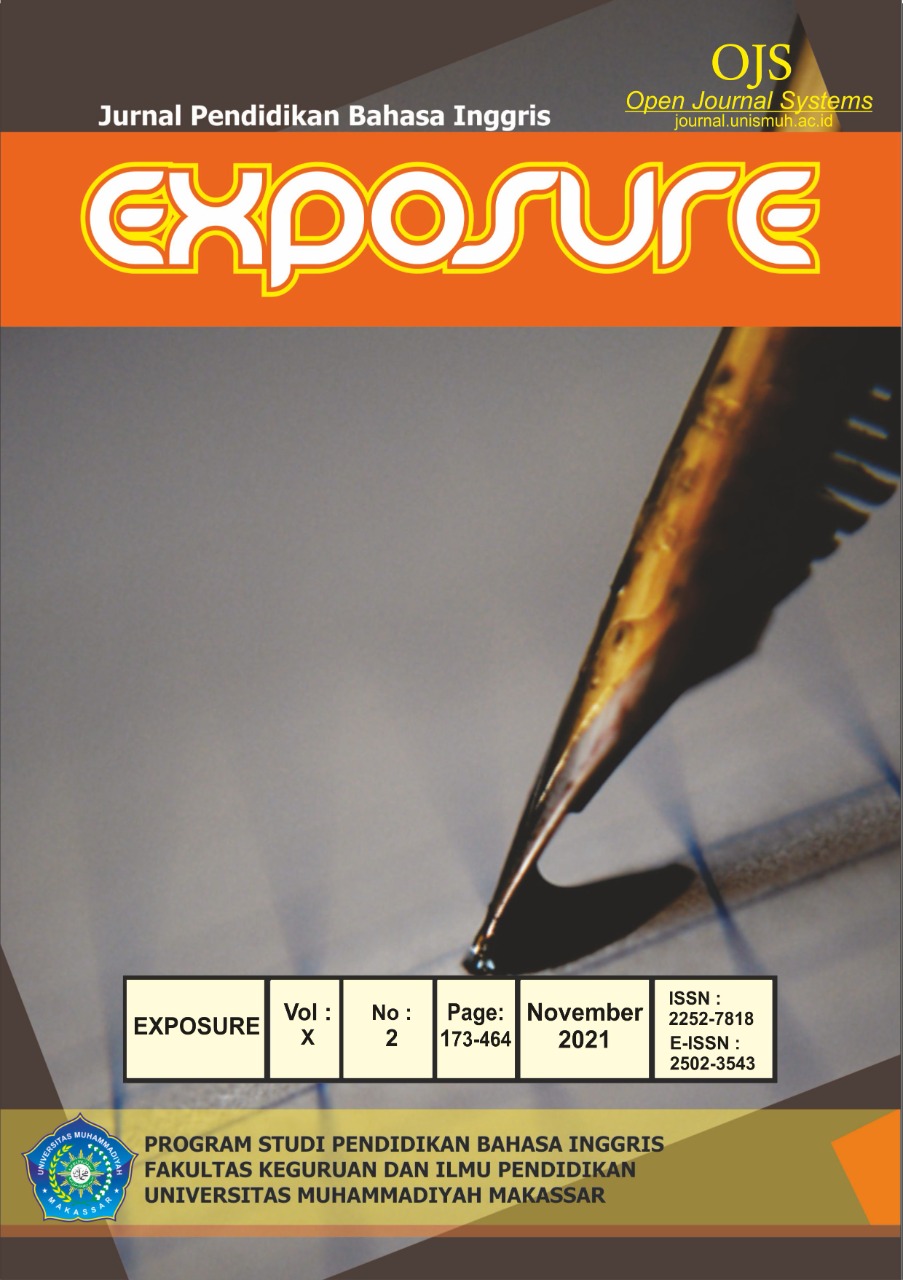WHEN LEARNING MEDIA PLAYS ROLES IN TEFL: HOME-VISITING STUDY CASE DURING COVID 19
DOI:
https://doi.org/10.26618/exposure.v10i2.5946Keywords:
Covid-19, home-visiting program, learning mediaAbstract
This study describes the implementation of learning media during the program of “home visit”. The activity involved 15 students of 6th grade of MI Unwaanul Falah, South Tangerang, as the subjects of the research. A qualitative-descriptive method was applied in this study. The researchers collected the data through observation, students’ assignment results and documentary pictures. The techniques in analyzing the data included data reduction, data display, and also conclusion and verification. The results of the research showed that the students responded to lessons better when the learning process was carried out in an interesting and interactive way, such as the used of diverse and concrete learning media which created enjoyable and appealing learning process during the COVID-19 pandemic.
References
Aini, W. N. (2013). Instructional media in teaching English to young learner: A case study in elementary schools in Kuningan. Journal of English Education, 1(1), 196-205.
Ameer Bakhsh, Sahar. (2016). Using Games as a Tool in Teaching Vocabulary to Young Learners. English Language Teaching. 9. 120. 10.5539/eltv9n7p120.
Asyhar, Rayandra. (2012). Kreatif mengembangkan Media Pembelajaran. Jakarta: Referensi Jakarta.
Djamarah, Syaiful Bahr, dan Aswan Zain. (2013). Strategi Belajar Mengajar. Jakarta: PT Rineka Cipta.
Getie, Addisu. (2020). Factors affecting the attitudes of students towards learning English as a foreign language. Cogent Education. 7. 10.1080/2331186X.2020.1738184.
Goldman, Susan & Pellegrino, James. (2015). Research on Learning and Instruction. Policy Insights from the Behavioral and Brain Sciences. 2. 33-41. 10.1177/2372732215601866.
Kemendikbud. (2013). Lampiran Permendikbud Nomor 81A Tahun 2013 Tentang Implementasi Kurikulum Pedoman Umum Pembelajaran. Jakarta: Kementerian Pendidikan dan Kebudayaan RI.
Miles,M.B, Huberman,A.M, dan Saldana,J. (2014). Qualitative Data Analysis, A Methods Sourcebook, Edition 3. USA: Sage Publications. Terjemahan Tjetjep Rohindi Rohidi, UI-Press
Millington, Neil. (2011). Using Songs Effectively to Teach English to Young Learners. Language Education in Asia. 2. 134-141. 10.5746/LEiA/11/V2/I1/A11/Millington.
Nassaji, H. (2015). Qualitative and descriptive research: Data type versus data analysis. Language Teaching Research, 19(2), 129–132. https://doi.org/10.1177/1362168815572747
Ngussa, Baraka & Abel, Chiza. (2017). Significance and adequacy of instructional media as perceived by primary school pupils and teachers in Kinondoni District, Tanzania. International Journal of Educational Policy Research and Review. 4. 151-157. 10.15739/IJEPRR.17.016.
Noble, H., & Heale, R. (2019). Triangulation in research, with examples. Evidence Based Nursing, 22(3), 67–68. https://doi.org/10.1136/ebnurs-2019-103145
Ospi. (n.d.). Washington Office of Superintendent of Public Instruction. Retrieved 2021–06-31, from https://www.k12.wa.us//
Puspitasari, D., Rahayu, W. W., Rohmatunnazilah, & Suwarno. (2020). Exploring the Feelings of International Students: When We Learn Virtually during the COVID-19 Pandemic. Journal of International Students, 10(S3), 142–160. https://doi.org/10.32674/jis.v10iS3.3204
Prayatni, Ida. (2019). Teaching English for Young Learners. Jurnal Ilmiah Profesi Pendidikan, 4(2), 106–110. https://doi.org/10.29303/jipp.v4i2.90
Resti, R., & Rachmijati, C. (2020). Analysis the use of instructional media on teaching english to young learner at elementary school in bandung. PROJECT (Professional Journal of English Education), 3(4), 453. https://doi.org/10.22460/project.v3i4.p453-458
Singh, V. & Thurman, A. (2019). How many ways can we define online learning? A systematic literature review of definitions of online learning (1988-2018). American Journal of Distance Education, (33)4, 289- 306. https://doi.org/10.1080/08923647.2019.1663082.
Sudrajat, Akhmad. (2011). Mengatasi Masalah Siswa melalui Layanan Konseling Individual. Yogyakarta: Paramitra Publishing.
Downloads
Published
Issue
Section
License
Authors who publish with this journal agree to the following terms:
In order to assure the highest standards for published articles, a peer review policy is applied. In pursue of the compliance with academic standards, all parties involved in the publishing process (the authors, the editors and the editorial board and the reviewers) agree to meet the responsibilities stated below in accordance to the Journal publication ethics and malpractice statement.
Duties of Authors:
- The author(s) warrant that the submitted article is an original work, which has not been previously published, and that they have obtained an agreement from any co-author(s) prior to the manuscript’s submission;
- The author(s) should not submit articles describing essentially the same research to more than one journal;
- The authors(s) make certain that the manuscript meets the terms of the Manuscript Submission Guideline regarding appropriate academic citation and that no copyright infringement occurs;
- The authors(s) should inform the editors about any conflict of interests and report any errors they subsequently, discover in their manuscript.
Duties of Editors and the Editorial Board:
- The editors, together with the editorial board, are responsible for deciding upon the publication or rejection of the submitted manuscripts based only on their originality, significance, and relevance to the domains of the journal;
- The editors evaluate the manuscripts compliance with academic criteria, the domains of the journal and the guidelines;
- The editors must at all times respect the confidentiality of any information pertaining to the submitted manuscripts;
- The editors assign the review of each manuscript to two reviewers chosen according to their domains of expertise. The editors must take into account any conflict of interest reported by the authors and the reviewers.
- The editors must ensure that the comments and recommendations of the reviewers are sent to the author(s) in due time and that the manuscripts are returned to the editors, who take the final decision to publish them or not.
Authors are permitted and encouraged to post online a pre-publication manuscript (but not the Publisher’s final formatted PDF version of the Work) in institutional repositories or on their Websites prior to and during the submission process, as it can lead to productive exchanges, as well as earlier and greater citation of published work (see The Effect of Open Access). Any such posting made before acceptance and publication of the Work shall be updated upon publication to include a reference to the Publisher-assigned DOI (Digital Object Identifier) and a link to the online abstract for the final published Work in the Journal.

